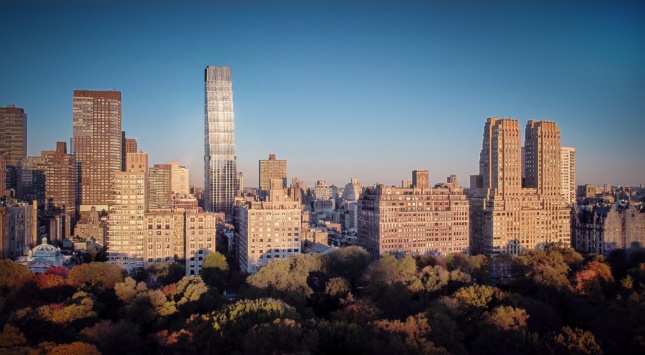A striking New York State Supreme Court ruling may force the developers of an Upper West Side condo tower at 200 Amsterdam Avenue to scale back their soaring design by 20 floors. While developments of this kind are often modified in the planning phase in order to comply with zoning regulations, this case has a twist: Construction of the 668-foot building is nearly complete.
Last Thursday, Supreme Court Justice W. Franc Perry ordered that the New York City Department of Buildings revoke the building permit for the development at 200 Amsterdam as well as demolish all floors that exceed zoning restrictions. The exact number of floors slated for removal remains unclear, but The New York Times reports that it could be 20 or more, depending on the final interpretation of the zoning laws. That’s quite a trim for a 52-story building.
200 Amsterdam, designed by Elkus Manfredi, occupies the lot where the original Lincoln Square Synagogue stood. In 2013, the synagogue moved to an updated building designed by CetraRuddy right next door, and renderings of the luxury condo high-rise first appeared in 2016. UWS community activists have viewed the project with contempt over the past few years, and many celebrated the ruling as a feat for community organizing.

“We are very gratified that after a long fight, the gerrymandered zoning lot at 200 Amsterdam has been declared illegal. This groundbreaking decision averts a dangerous precedent that would have ultimately affected every corner of the city,” said Elizabeth Goldstein, president of the Municipal Art Society of New York (MAS), in a press statement.
In a statement to AN, developers SJP Properties and Mitsui Fudosan defended their vision for 200 Amsterdam and indicated plans to appeal the ruling:
“This ruling is a shocking loss for New York City and its residents. It defies more than 40 years of precedent in the city’s zoning laws. It also ignores the thoughtful decision of the DOB to grant the permit which was upheld by the BSA following exhaustive document review and testimony over a two-year period. Both of those decisions recognized that retroactively applying new interpretations of the city’s zoning to previously approved projects undermines the stability of the regulatory environment needed to support the investment that is critical to New York City’s economy, tax base, housing stock and services. We will appeal this decision vigorously in court and are confident that we, and the City, will prevail on the merits.”
While the retroactive trimming of a nearly-finished tower is certainly unusual, it is worth noting that New York has seen this situation before—in 1991, a New York developer was forced to tear down the top 12 floors of a 31-story residential tower at 108 East 96th Street five whole years after it was built. This marked the most severe consequence a New York developer had ever faced for zoning violations; the NYT reporting from 1991 claims that developers of the project repeatedly blamed the violations on an “error in a city map.”
The immediate future of 200 Amsterdam remains unclear, but the potential of a partial demolition presents a unique set of challenges, especially with some of the most profitable units located on the upper floors.











